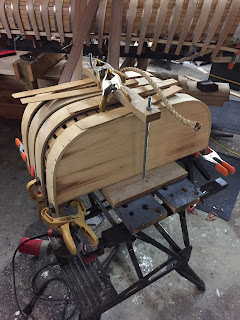Time to drag out the form and put one together for the Gr8 homeroom teacher. Good teachers just make you want to build...
Leftover big pine from what was used to plank the form. A really kool piece was kept for the lid
Old pine sides, white cedar ribs and western red cedar planking
Making the turn around the bottom
Planked and ready to lift from the form.
Finished, sanded and ready for tung oil
That satisfying moment when the oil hits the sanded wood
Oiled inside and out, 3 coats rubbed and paste furniture wax rather than varnish
The apprentice oiling the lid next
Walnut, pine and WRC
Second coat of oil soaking in
Ready for furniture wax
The lid, complete with blue staining from Pine Wilt disease,
more here:
- Pine wilt is a lethal disease caused by a native nematode (Bursaphelenchus xylophilus), vectored to trees by a wood borer insect–the pine sawyer beetle (Monochamus spp.).
- Rapid change in needle color from green to gray-green to brown or light tan, beginning in late summer
- Wood from recently affected trees is very dry, brittle and lacks any resin accumulation when cut. No evidence of exit holes, sawdust, or pitch tubes associated with bark beetles or wood borers in branches or the trunk
- The wood is discolored by blue stain fungi
- The blue stain fungus, Grosmannia clavigera, is a species of sac fungus. It spreads to lodgepole pine, ponderosa pine, Douglas-fir, and whitebark pine trees from the body and a special structure in the heads of mountain pine beetles. The blue stain fungus has evolved a relationship with mountain pine beetles that allow them to travel from tree to tree on a special structure in the beetle’s heads and stops the tree from producing resin to pitch out or kill the beetle, encouraging the pine beetle infestation
- The blue stain fungus spores germinate and produce a thread like mass (mycelium) that colonizes the phloem and sapwood. Fungal spores are usually blown away by wind but blue-stain spores are "sticky." This process eventually blocks the nutrient-conducting columns of the tree draining the trees of their nutrients eventually causing the tree to starve to death.[4] The symptoms and signs of blue stain fungus are a blue-gray discoloration of sapwood in wedge shapes of recently killed trees












